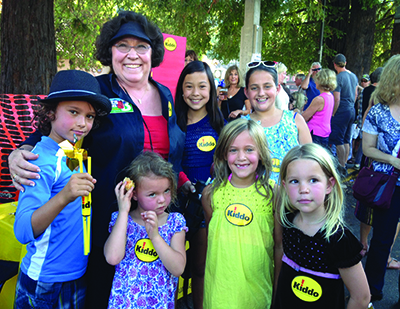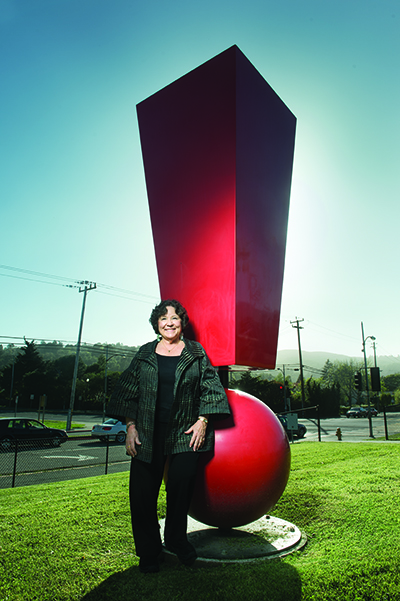When the Marin Independent Journal commemorated Trisha Garlock’s retirement earlier this year, it used the words “tireless commitment” to describe her career. That seems like a vast understatement for the woman who served as executive director of Mill Valley’s public schools foundation, Kiddo!, for the past 32 years. Since starting the foundation in 1981 with her neighbor and fellow mom, Penny Weiss, Garlock has seen Kiddo! grow from a small grassroots operation to one that raises $3 million a year and is a model for other schools foundations nationwide. Since (kind of) leaving Kiddo!, she has transitioned over to her new role as president of the board of SchoolsRule, an organization dedicated to funding public education throughout the entire county.
After all these years, why the switch to SchoolsRule? It wasn’t really a switch; I’ve been working on SchoolsRule since its inception in 2010, when it was just a loosely formed group of schools foundations from all over Marin. I was working with the group as a volunteer, in addition to my paid position with Kiddo! But SchoolsRule has grown and they need someone who can devote more time to it. It’s been a nice transition for me, after retiring. But, of course, I’m still going to help raise money for Kiddo!
What is SchoolsRule? SchoolsRule is a coalition of all 20 individual schools foundations working together to benefit every public school student in Marin. Each individual foundation is continuing to raise money in its own community, but we’re pursuing the larger corporations that serve the whole county. We’re also raising funds from the 80 percent of Marin residents who do not currently have a child enrolled in public schools.
Why is there a need for this? The southern Marin districts have an easier time raising funds, which means there’s a disparity in the county. Mill Valley and Kentfield, for example, might be able to raise a lot of money, but our two biggest districts — Novato and San Rafael — have a much harder time because they are more economically diverse. With SchoolsRule, we distribute our allocations so that each student in Marin is given the same amount. That means that the most money goes to the two biggest districts, which happen to also be the ones in the most need. It’s a way of leveling the playing field.
But why is there a need for schools foundations at all? Ideally, there shouldn’t be a need for these types of foundations. When Penny and I started Kiddo! in 1981, our goal was to be out of business in five years. We thought it was just a temporary lapse of judgment by the state of California that they were cutting so much education funding because of Proposition 13. We thought they’d surely restore it. But they haven’t. What people need to realize is that even with the state’s budget surplus now and the increased money for education, our schools are still only being funded at the level they were in 2007. I think it’s unconscionable that the state doesn’t fund schools properly.
How did Kiddo! get started? It was just a few years after Proposition 13 passed and Penny was the president of the PTA at Old Mill School and I had a two-year-old and was working in the city, fundraising for an arts organization. We were having tea together and she was lamenting the fact that the school was going to lose its arts and music programs. At the time, her PTA was doing bake sales and she said, “How can we fund teachers’ salaries on bake sales?” When I was growing up, the California schools were incredible. They were among the highest-funded schools in the country; I had orchestra, I was in a play, I had art programs. I couldn’t imagine the public school system without the arts, and Penny couldn’t either, so we felt it was the community’s responsibility to make sure kids had these programs.
Kiddo! is considered a role model for schools foundations nationwide. Why is that? We were one of the first foundations to use the [fundraising tool] eScrip and also to enter into partnerships with the smaller businesses in our community, the mom-and-pop businesses. We were always willing to try things, and we were also willing to share.
Your kids are 29 and 34 now; why stay on so long with Kiddo!? You know, many people have asked me that over the years. But for me, it was always the students who inspired me. All I had to do was go to a second-grade play or music or dance performance and see the joy on these kids’ faces. It was a constant inspiration. I think it’s important for all kids to receive a quality education, not just your own.
What about describing your work as “tireless commitment”? There have been over 250 Kiddo! board members who have shown tireless commitment. There have been 19 chairmen of the board who have shown tireless commitment, and there have been thousands of volunteers. I just happen to have been there the longest.
What has SchoolsRule achieved so far? In 2012, the first year we gave money away, we distributed $200,000. In 2013, we distributed $400,000. This year, we’re hoping to double that again, to $800,000. We’ve had all sorts of contributors get on board, including Wells Fargo, Kaiser and the Marin Community Foundation. Dave Gilmour of Paradise Foods believes in us so much, he contributed $100,000. And because of this, we were able to save a music position in San Rafael — and then add to that position a year later — and we were also able to save a librarian in Novato. All of the money has gone for arts, technology or literacy programs.
 What are the biggest challenges facing SchoolsRule? Getting the word out into the community. We’re a relatively new organization. But we got a big boost from the Marin County Fair last year, when they made us the theme partner. They also let us use the big pavilion tent — the one usually used for music — for a SchoolsRule fundraising event. We had dozens of corporate sponsorships and people who bought tables. We’re having another one this year, with the same theme of “Enchanted Circus,” on July 1, right before the fair opens.
What are the biggest challenges facing SchoolsRule? Getting the word out into the community. We’re a relatively new organization. But we got a big boost from the Marin County Fair last year, when they made us the theme partner. They also let us use the big pavilion tent — the one usually used for music — for a SchoolsRule fundraising event. We had dozens of corporate sponsorships and people who bought tables. We’re having another one this year, with the same theme of “Enchanted Circus,” on July 1, right before the fair opens.
How do you think we’re doing as a county, supporting public education? I think everyone in Marin realizes that we have one of the best educational systems in the state because of the fact that the parents and the community get behind it with parcel taxes, contributing to schools foundations and being involved with the schools. If you have involved parents, you’re going to have great schools.
But are we there yet? No. We have a long way to go. And until the state of California funds schools properly, so that all children can have the arts, technology and all the programs we need for a well-rounded education, it really is incumbent upon the community to fill the gap. It doesn’t sound like you’ve really slowed down in retirement. My husband says I don’t understand the definition of the word.


